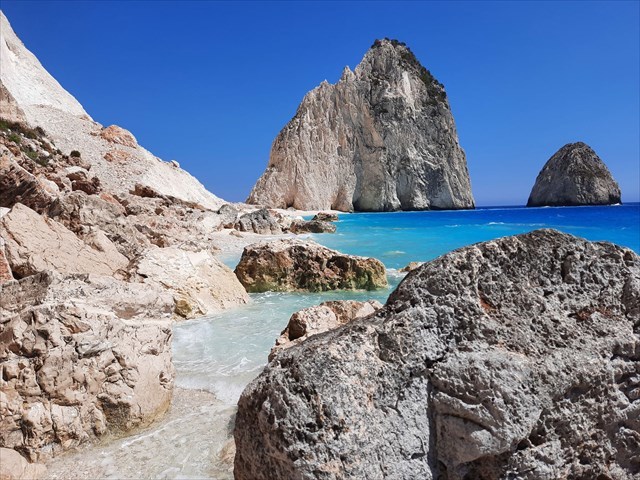 Mizithra are two white rocks with the shape of a pyramid on the southern most part of the Zakynthos island. They got their name from a local white feta cheese called Mizithra. Individually the rocks are named Megali Mizithra ("large white cheese") and Mikri Mizithra ("small white cheese"). When you come to this place by boat (highly recommended for your private observation and geological research
Mizithra are two white rocks with the shape of a pyramid on the southern most part of the Zakynthos island. They got their name from a local white feta cheese called Mizithra. Individually the rocks are named Megali Mizithra ("large white cheese") and Mikri Mizithra ("small white cheese"). When you come to this place by boat (highly recommended for your private observation and geological research  ), you will be enchanted by these two rocks rising from the sea and also by the coastline to the north, reminiscent of the moon landscape.
), you will be enchanted by these two rocks rising from the sea and also by the coastline to the north, reminiscent of the moon landscape.
Geology
The rocks and coastline are not from cheese (not, for sure  ), they are, from a geological point of view, created mostly from limestone. Limestone is a typical representative of sedimentary rock, about 10% of sedimentary rocks are limestone. It is a carbonate sedimentary rock that is often composed of the skeletal fragments of marine organisms such as coral, foraminifera, and molluscs. Its major materials are the minerals calcite and aragonite, which are different crystal forms of calcium carb
), they are, from a geological point of view, created mostly from limestone. Limestone is a typical representative of sedimentary rock, about 10% of sedimentary rocks are limestone. It is a carbonate sedimentary rock that is often composed of the skeletal fragments of marine organisms such as coral, foraminifera, and molluscs. Its major materials are the minerals calcite and aragonite, which are different crystal forms of calcium carb onate (CaCO3) – more than 80%. Most grains in limestone are skeletal fragments of marine organisms. These organisms secrete shells made of aragonite or calcite, and leave these shells behind when they die. Other carbonate grains composing limestone are ooids, peloids, intraclasts, and extraclasts. Limestone could contain different impurities (such as clay (gray color), sand (yellow color), organic remains, iron oxide (orange-brown color), and other materials), which will cause limestone to exhibit different colors. Limestone is generaly soluble in water. It could be dissolved (or precitipated) depending on a several factors of the water - temperatrure, pH or pressure (sea waves) or the limestone - its hardness, homogeneity or impurities.
onate (CaCO3) – more than 80%. Most grains in limestone are skeletal fragments of marine organisms. These organisms secrete shells made of aragonite or calcite, and leave these shells behind when they die. Other carbonate grains composing limestone are ooids, peloids, intraclasts, and extraclasts. Limestone could contain different impurities (such as clay (gray color), sand (yellow color), organic remains, iron oxide (orange-brown color), and other materials), which will cause limestone to exhibit different colors. Limestone is generaly soluble in water. It could be dissolved (or precitipated) depending on a several factors of the water - temperatrure, pH or pressure (sea waves) or the limestone - its hardness, homogeneity or impurities.
The rock was created (from the geological-historical point of view) in Eocene epoch, which lasted from about 56 to 33.9 million years ago. It is the second epoch of the Paleogene Period in the modern Cenozoic Era.
Warning: Due to "bad" weather, it is often forbidden by the Coast Guard to enter the cache site behind the Mizithra cliff directly by boat. The best way is to anchor in the bay on the southern side and walk to the cache over a small stony tongue or to swim/walk through one of the easily accessible caves in the Mizithra cliff near the beach. The visit of the place is really worth it!
Questions:
1) Is the limestone soluble in water? Try to describe your observation from both aspects – sea water (color, turbidity, transparency) and rocks (relief, cavities, erosion).
2) As described above – limestone very often contains some impurities. One impurity is visible in the parts of the cliff and also in big alone stones on the beach (norther direction from Mizithra). What is the color? What impurity could be present (according to its typical color)?
3) Limestone is a representative of sedimentary rock. What is the rough percentage of limestone occurrence in the total sedimentary rock presence on our planet.
4) Optional – Take a photo with Mizithra rocks from the Northern side
Sources: